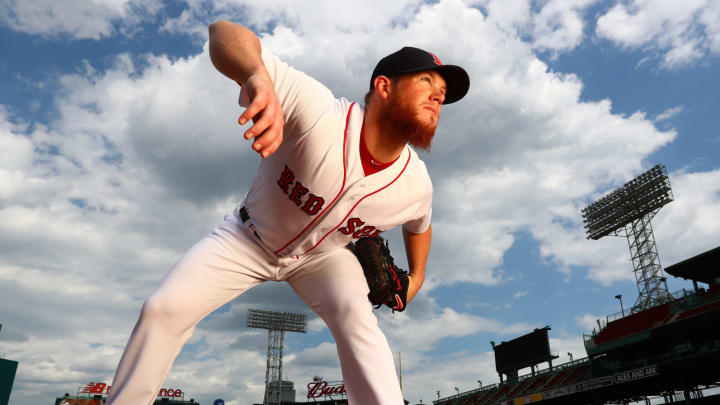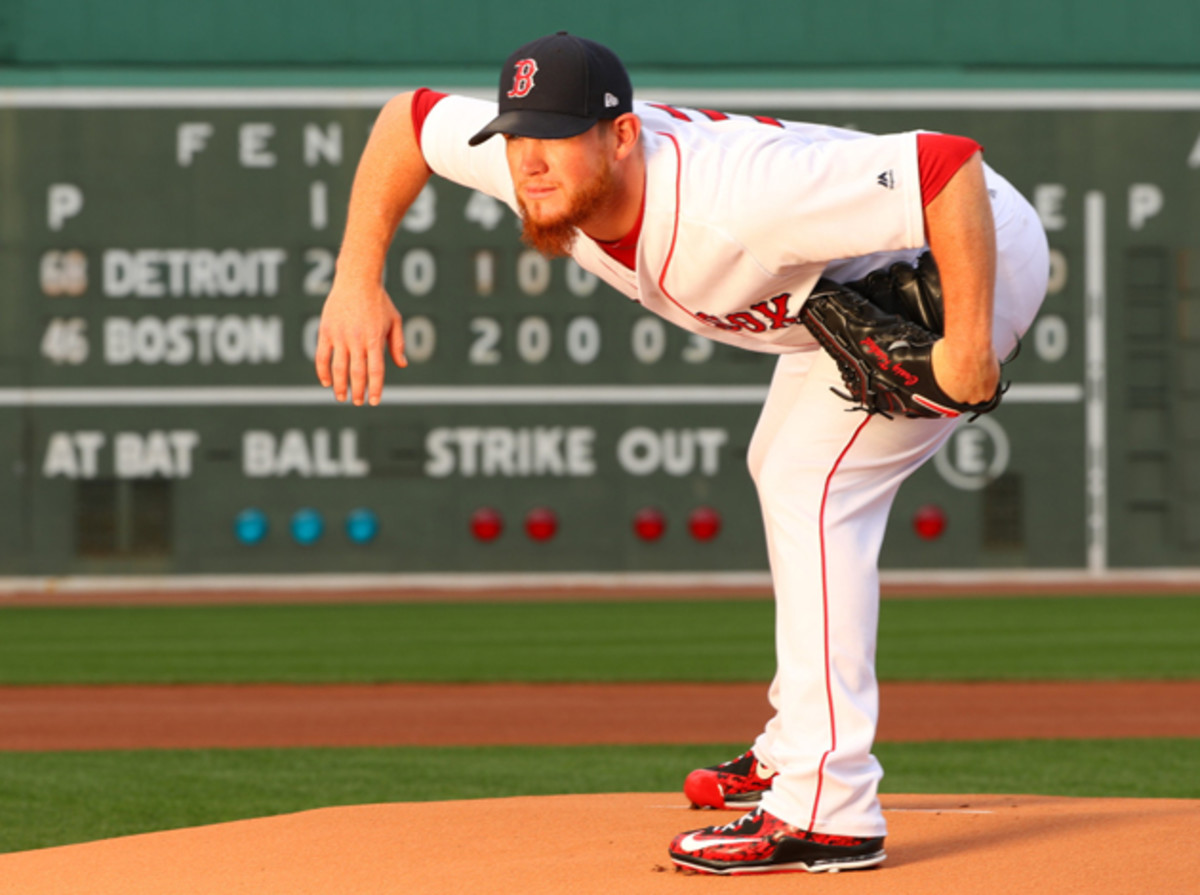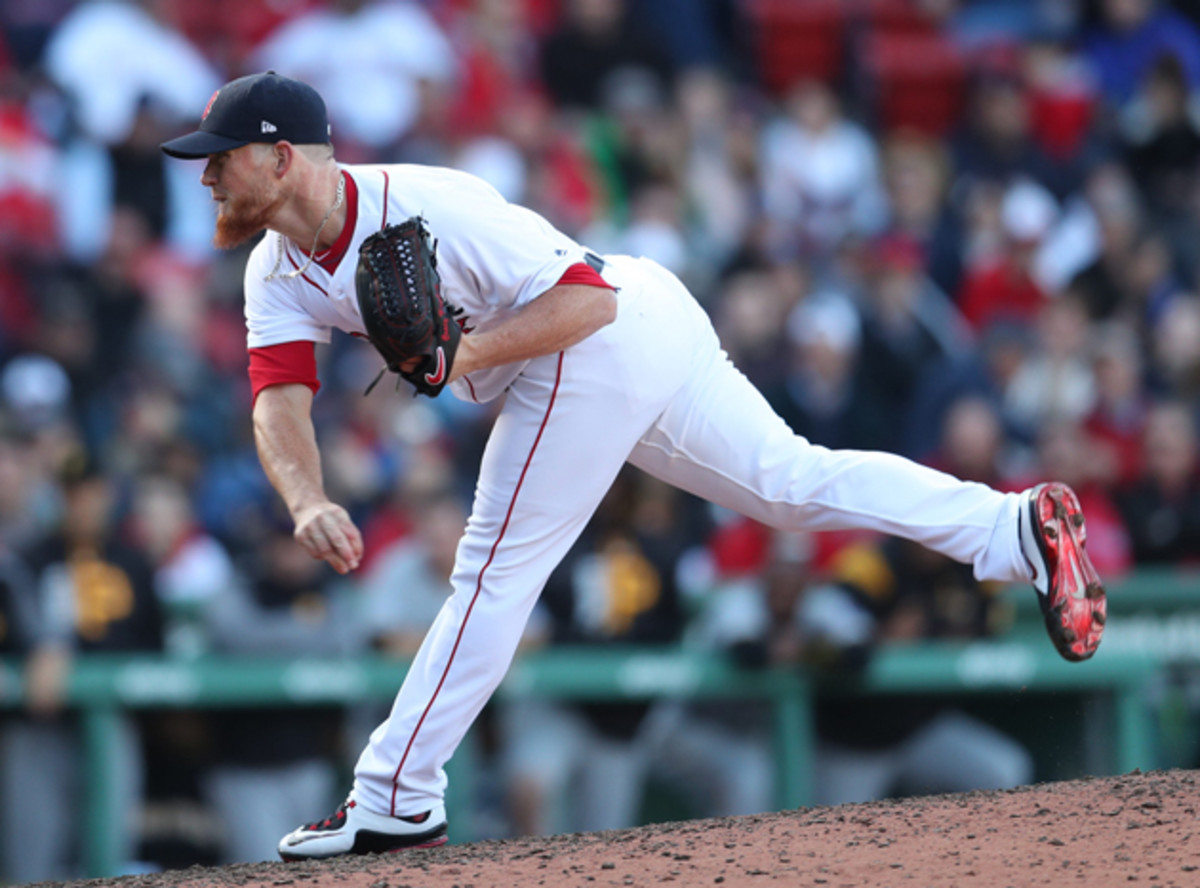Special K: Red Sox closer Craig Kimbrel is compiling one of the greatest seasons ever

This story appears in the June 26, 2017, issue of SPORTS ILLUSTRATED. To subscribe, click here.
When Craig Kimbrel stepped on the pitching rubber at Yankee Stadium on June 6 and took his predatory, pterodactylian pose—bent at the waist, right arm held askance like an open wing—what had been a taut baseball game between New York and Boston, with its usual parry and thrust, instantly became something else. It became a one-man Broadway show, a well-attended game of catch between Kimbrel and his catcher, Christian Vázquez, and an emphatic statement about relief pitching evolved to its highest order.
Summoned in the eighth inning, Kimbrel would throw 30 pitches to close a 5–4 Red Sox win. The Yankees put none of them in play. Kimbrel obtained the final four outs while striking out five batters, the overage due to a devious 88-mph curveball that was as hard for Vázquez to catch as it was for the batter, Didi Gregorius, to hit. The outing made Kimbrel the first pitcher in history with three games in which he recorded more strikeouts than outs while working at least one inning.
Such lack of contact has become routine against Kimbrel. He is a human mute button. Never has a baseball been more unhittable than when Kimbrel throws it. Already the toughest pitcher to hit with at least 400 career innings (.152 batting average against), Kimbrel is building what could be the most unhittable season in history. Opponents are batting .086 against him, which would blow away the record by a pitcher with at least 60 innings. Naturally, that record (.126) is held by Kimbrel, vintage 2012.
The 30: The Dodgers, Rockies and Diamondbacks are the National League's finest
In 30 appearances this year Kimbrel has allowed only 46 balls to be put in play. He gave up one hit in May. Righthanded batters began the year 0 for 47 against him. He has faced 111 batters and struck out 59, an all-time-record rate of 53.2%, while walking only five.
“You couldn’t even do that in a video game,” says Boston reliever Joe Kelly. “The game won’t even let you strike out that many. And he’s doing it in the major leagues. He has the best stuff I’ve ever seen.”
Relief pitching is the monster that is swallowing baseball as we used to know it, and it is growing. Relievers threw more innings last year than in any other season in history, and they are on pace to break that record this year. Buoyed by increased velocity and a growing inventory of power arms, teams are making a priority of not just getting outs from relievers but also keeping the ball out of play. The 10 highest bullpen strikeout rates of all time have occurred in the past 10 seasons, and this year’s rate for the first time has cracked the threshold of one strikeout per inning.
Offense is wilting in the back half of games. Hitters are batting .244 against relievers, a number that could challenge the lowest mark in history—.237 in 1968, when offense was at its modern nadir and bullpens threw half as many innings as today. There is no foreseeable end to the trend. Last year 36 major leaguers, including Kimbrel, threw 100 mph, according to Statcast data. Meanwhile, at least 71 minor league pitchers hit 100, according to Baseball America, a 37% increase in minor league triple-digit flamethrowers in just three years.
Kimbrel is the standard-bearer for this movement of ferocious pitching, unlikely considering he's barely 6 feet, went 3–7 as an undrafted 160-pound high school senior, was demoted to low A ball in his second year in the minors, has a soft philanthropic heart, rides his bicycle to Fenway Park, is so laid back that he naps before the first pitch, and he blows up hitters without taunts or gamesmanship. Opposing fans have a hard time working up dislike for him.
“People hate me just because of the uniform I’m wearing,” he says. “They don’t know who I am. Honestly, I can’t even say that’s their true feeling. It’s more like, ‘O.K., I feel like I need to yell at you. I feel like I need to rag you.’
“I love it. God gave me the ability to throw a baseball, and I get to do it with conviction against the best in the world every night.”

To hear Kimbrel tell the story, his power may be divinely bestowed, but sheetrock enhanced it. From the time he was 12, Kimbrel would work summers as a helping hand for his father, Mike, an electrician in Huntsville, Ala. One day in 2006, after graduating from Lee High and having committed to pitch at Wallace State, a junior college in Hanceville, Ala., Craig was on a residential job with a friend and Matt, one of Craig’s brothers. Mike was working on another house.
Craig and his friend needed to install an outlet in the kitchen. First they’d have to move a stack of about a dozen sheetrock panels that leaned against a wall. “We grabbed the sheetrock, and all of a sudden the whole stack was coming down on me,” Craig says. “It happened real fast. I tried to get out of the way, but it didn’t work out so well. The sheetrock fell on my left foot and broke it. They rushed me to the hospital.”
Kimbrel’s foot was in a cast for three months. To keep his arm fresh, he would play long toss from his knees at a nearby soccer field. He would throw a yellow, dimpled, rubber-coated ball the length of the field over and over. Kimbrel believes this not only increased his arm strength but also allowed him to learn about generating power from his torso by being forced to isolate his upper body. (Limited from workouts by the cast, he also gained weight; he now weighs 200 pounds.)
Not long after returning to pitch in the spring as a starter, Kimbrel, who threw in the low 90s in high school, hit 95. The Braves, his favorite team, drafted him in the 33rd round, but Kimbrel returned to Wallace State for a second season. Atlanta drafted him again—this time 30 rounds earlier. The Braves took stock of a short, righthanded pitcher with a power arm and a mediocre changeup and immediately told him his future would be in the bullpen.
“I didn’t want to do it at first,” he says. “Everybody wants to start. But when they told me I’d probably get to the big leagues faster if I was in the bullpen, I was like, ‘O.K. That’s fine.’
“The key for me is every pitch I throw, I want to throw like, ‘I’m trying to get this by you.’ Starters can’t always do that.”
Specialization suits an all-out pitcher who doesn’t have a third pitch. Kimbrel has appeared in 575 professional games, all but one (on a rehab assignment last year) in relief, and never thrown more than three innings. He has never faced a major league hitter for the second time in a game.
Cleveland Indians ace Corey Kluber is getting smart and diversifying his pitch selection
His path to the majors took a detour in 2009 when the Braves demoted him and his 10.97 ERA from high A Myrtle Beach to low A Rome. Kimbrel had tried to improve his changeup, an effort that caused him to lose his arm slot, his control and his velocity. The pitching coach at Rome, Jim Czajkowski, gave Kimbrel some advice: “Forget throwing the changeup. Just be an aggressive pitcher. Go get ’em. You’ll quit dropping your arm and you’ll quit walking guys.’ ”
Says Kimbrel, “That’s what I’ve done ever since.”
He was in the big leagues the next spring at age 21 and was named the National League Rookie of the Year the following season. During those years with the Braves, Kimbrel was so touched by team visits to children’s hospitals that he and his wife, Ashley, began regularly donating time and money to support pediatric cancer research and treatment. The couple is expecting their first child in November.
“We all at one point looked up to ballplayers,” says Kimbrel, “so it’s important to understand there’s children out there doing the same to you.” He regularly receives fan mail from kids who are “Kimbreling,” posing in the idiosyncratic pre-pitch stance he began using in the 2010 postseason. (“I don’t know why I did it, but it worked, and when something works, you don’t change it,” he says.)
He wound up in Boston last year after trades by the rebuilding Braves and Padres. He has made five All-Star teams, led the league in saves four times (he leads again this season) and has seen his average fastball velocity increase from 95.3 as a rookie to a career-high 98.7 this year. Batters are hitting .079 this season against his fastball, the lowest batting average against that pitch in baseball.
“He’s just got the perfect fastball,” Kelly says. “He has the perfect spin rate, the perfect velocity and the perfect release. It’s truly rare. Even when I play catch with him, the ball comes out of his hand like nobody else’s. When I’m done playing catch with him I always retie the strings and laces on my glove because they come loose. Imagine trying to hit it.”
Says Yankees DH Matt Holliday, “First of all, he’s throwing 98, 99, so that’s hard enough. But there’s something about the way he throws it that makes it so difficult to track. You swing at one place, and very rarely does the ball end up at that place.”
Kimbrel’s fastball averages 2,324 revolutions per minute, slightly more than the major league average of 2,225. As important as the velocity or spin rate is the way Kimbrel throws the ball—and it goes back to the sheetrock accident.
Like great hitting, great pitching requires separate and sequential rotations—the turn of the hips followed by the turn of the torso, like one tornado atop another. After a pitcher brings the ball up to its loaded position, the hips fire first, followed by the torso, after which the arm and hand come around, using energy generated by the sequential cyclones.

Drawing from that regimen when he used to throw from his knees, Kimbrel generates exquisitely timed and power-fully fast rotations. As his belt buckle turns toward the hitter in the first rotation, the boston across his jersey remains facing third base in a closed position to the batter’s box. When his torso finally does turn to deliver the arm and hand—with his chest leading toward the plate—a hitter perceives that his arm is coming around late.
With the late rotation, Kimbrel hides the ball longer from the hitter, and when he keeps his hand directly behind the ball from his low three-quarters delivery, he gets the “perfect fastball spin” that Kelly noted. It is true south-to-north backspin, the greatest gravity-fighting spin. The ball appears to “hop” to the hitter because it doesn’t sink the way normal fastballs do.
There is one more special ingredient to the Kimbrel heater: trajectory. The typical pitcher throws with a stride about equal to his height. At 5' 11", Kimbrel is an undersized pitcher with an above-average stride length: about 6' 4". Combining his short stature, his long stride and his low release point, Kimbrel lets go of the baseball only five feet off the ground—unusually low. Hitters are unaccustomed to seeing fastballs thrown with an overhand delivery so low to the ground. When Kimbrel throws at the top of the strike zone or above, as he often does, the baseball does not seem as if it’s traveling downhill, as hitters are accustomed to. It appears to stay on a flat plane or, when it’s especially high, to hit the catcher’s mitt higher off the ground than when it left his hand. “It looks like it’s coming out of his shirt and going up,” says Holliday.
Kimbrel’s odd flight path has been made more effective by the modern hitter’s preference for hitting up on the ball to create lift. Kimbrel says he has learned how to read hitters’ swings to know the proper planes on which to throw his fastball and curve.
“[A batter’s] swing plane is going to tell you what he can and cannot get to,” Kimbrel says. “I think your chances of getting a swing and miss or a pop-up is better because guys are hitting that low pitch now. It’s flip-flopped. When I first came up, it was, ‘Pound it down in the zone, pound it down in the zone.’ So now it’s, ‘Throw it up in the zone and throw your off-speed down in the zone.’ It’s been interesting to see it change in the last six, seven years.”
After breaking record, how does Cody Bellinger's season compare to Aaron Judge's?
Kimbrel is perfectly equipped for this specialized game, especially now that manager John Farrell sometimes deploys him in the eighth inning. Kimbrel has secured more than three outs in games as many times this year as he did all of last year (five).
“Nothing is automatic,” Farrell says, “but Craig Kimbrel is darn close.”
Says Kelly, “What’s really amazing is he has the world’s slowest heartbeat. He never panics. Never.”
Kimbrel will spend the last half hour before a game napping in the clubhouse. When he wakes up, he stretches, gets a massage, applies red-hot ointment to his arm, walks to the bullpen in the fifth inning and chats amicably with his buddies. “I’m chill until it’s time for me to step on the bullpen mound,” he says. “Mentally, I can lock in as soon as I toe the rubber, and as I come through the gate I get to the next level.”
The June 6 game at Yankee Stadium typified how endgames in baseball have become stunning displays of power pitching with little contact and few rallies. Protecting a lead over the final three innings, Boston relievers Kelly, Matt Barnes and Kimbrel threw 64 pitches, 45 of which registered 95.3 mph or above. The Yankees hit only one of those 64 pitches out of the infield, their only hit against the relievers.
The odds of stitching hits together against Kimbrel are especially high. Only eight times in 437 games has Kimbrel allowed three hits in one inning, and never in his past 49 appearances.
He ended the night in a flourish. Facing New York rightfielder Aaron Judge, the league’s leading home run hitter and one of its hottest batters, Kimbrel threw a trio of fastballs at the top of the strike zone, each one harder than the last, starting with a 98.2-mph heater for a called strike and one at 99.4 for a swinging strike.
“The velocity is not the feeling I’m looking for,” he says. “It’s how the ball comes out of my hand. The radar gun doesn’t always tell the truth, especially with life on the fastball. That’s what spin rate is. That’s life.
“I don’t even know what the trick is to create it. I don’t know if it’s the wrist, the arm angle, how long you hold the ball or what. The only way I can describe it is, it feels right.”
The last pitch shot out of his hand perfectly, traveling 99.6 mph, spinning madly, and crossing the plate just about the same height off the ground as when it left his hand. Judge swung, but the pitch, like most from Kimbrel, was unhittable. When the ball popped into Vázquez’s mitt, it was the sound of Kimbrel again putting his stamp on baseball, as if affixing a raised seal to an official document. This, his fastball notarized, is the right pitcher with the right stuff at the right time. This is state of the art.
